Reece High School Grade 8
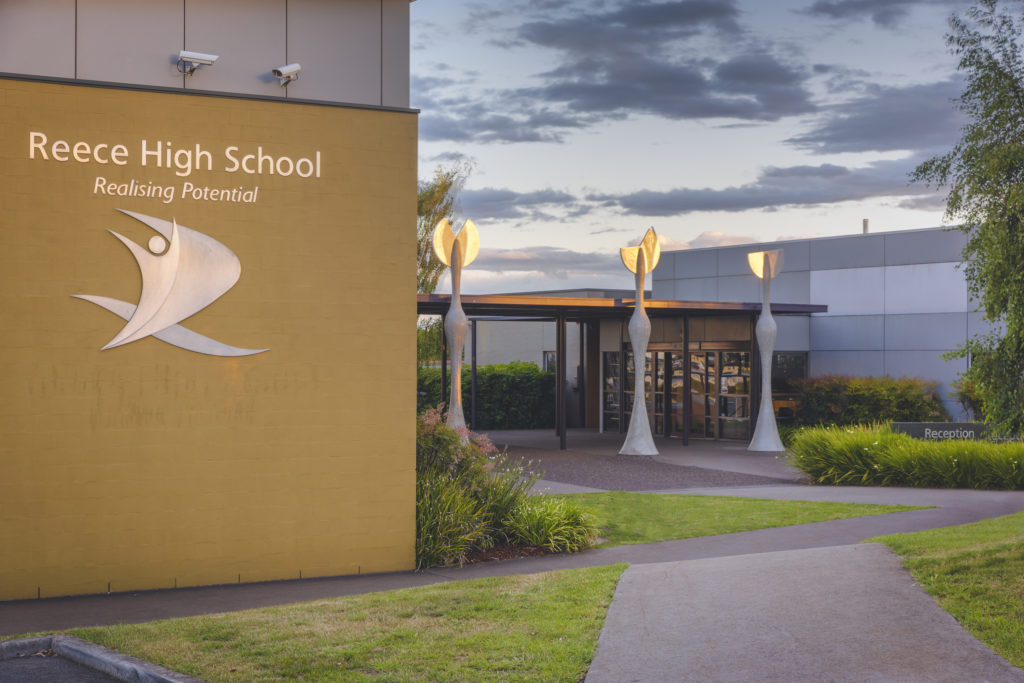
All four Grade 8 classes collaborated on this list of 26 questions.
Our Questions
Climate change and its causes will affect your generation in many different ways, in Australia and elsewhere. These include rising average temperatures, more frequent and severe storms, floods and bushfires, and extinction of plants and animals. The loss of topsoil from drought, flood and wind and unpredictable weather will affect farming and could cause more frequent and severe famines. This could lead to increasing political tensions in some countries around access to resources. People and governments will need to spend more money on safety and preparedness. These impacts are all related to one another.

A lot of produce will become more expensive as environments change. This includes coffee and honey, and even some vegetables, fruits and meat. Campfires, burn-offs and open-flame barbeques would be restricted for longer parts of the year as fire bans become increasingly common. Take the example of the 2020 bushfires. More than 3 billion animals were impacted, forests were damaged or destroyed, and human tragedies included loss of life, health, homes and livelihoods. Crises like this would be repeated in increasingly worse fire seasons, meaning bigger and bigger expenses for fire preparedness. Taking action on climate change will not stop these impacts entirely, but it can reduce them.
Climate change and its causes impact more than the natural environment. They have knock-on impacts in health. Air, water and soil pollution will continue to cause health conditions and worsen existing ones like cardiovascular and respiratory diseases as well as cancers. While these outcomes are less common in Australia, they happen here too. People in poorer communities with fewer support structures are impacted most. Your generation will see these impacts in your lifetimes. In fact, you already have. Increased exposure to new infectious diseases in the environment has also been linked with climate change, meaning epidemics and pandemics may be a thing of the future and not just the present.
While these impacts cannot be stopped completely, there is so much that can be done to avoid the worst of it. If we rapidly reduce the greenhouse gas we emit, we can improve the future for your generation and the generations who follow you. Action on climate change now will play an important part in your future quality of life, and in the lives of many others around the world in your lifetime.
Thank you for your question. I think there are two different parts to your question.
The first one may relate to weather rather than climate. Weather and climate are not the same thing. Weather is what happens from one day to the next, and yes, it certainly does change a lot, especially in Tasmania. Climate is the average weather over time.
Let’s talk about weather in Tasmania first. Our weather is affected by processes on a range of scales, and by other factors. One of these important factors in Tasmania is what we call topography – or land form. We have a lot of mountains in the west that rise up to Central Plateau and then in the east the land is generally flatter and lower elevation. Tasmania sits in a region known as the ‘Roaring Forties’ and most of our weather comes from the west
due to the way the atmosphere is ‘organised’. This means that when weather systems hit the west, they drop most of their rain in the west because the clouds carrying the rain have to rise up to get over the mountains. There’s often not much left by the time they get over the Central Plateau.
Another factor is that Tasmania is only a small island. You’ve probably seen weather maps like the one below. Low and high pressure systems pass over Tasmania. Air circulates clockwise around a low pressure system and anticlockwise around a high pressure system. Think about the low pressure system in the map that’s passing over southeastern Australia. If air circles clockwise around this system it means its picking up a lot of moisture from the Tasman sea which then gets dumped along eastern Australia, including Tasmania. As it moves further east – due to dominant westerly winds – we will start to get colder air from further south. If we had a high pressure system passing over Tasmania instead, we would first see winds from the south and then as it passed further to the east, the wind would come from the north. Winds from the north are warmer than winds from the south. Slightly
different locations (e.g. whether they are further south or further north) will also make a difference. So, our weather changes as one system passes over us and sometimes we can get four seasons in one day.
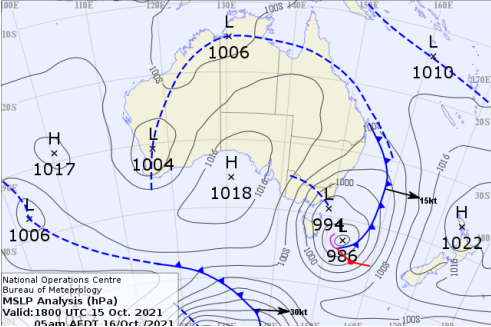
Now, in relation to a constantly changing climate. When we talk a about a changing climate, we’re talking about longer time scales. How long depends on your perspective. For example, people who work with just data that has been measured over the past century would look at trends and change over the past century. Others who study what we can find out about climate from things like sediment, ice cores, tree-rings or corals will look at how climate has changed over hundreds or thousands of years. Some people will look at changes in rainfall and others might look at changes in temperature over land or temperature of the sea.
Just a few things that affect climate over different time scales are:
- Changes in what we call ‘modes of variation’ like El Niño-Southern Oscillation which affects rainfall in eastern Australia in particular (there are other modes of variation, but you’ve probably heard about El Niño – the others are not so often spoken about). El Niño for example has a ‘sort-of’ cycle of about 7 years.
- Human-induced changes like greenhouse gas emissions. Very important factor over the past ~200 years
- Things like sunspots that affect how hot the sun is. Less sunspots mean a cooler sun that then affects how warm Earth is. These can affect Earth’s climate for several decades at a time.
- REALLY long-term changes like how the Earth orbits the sun. This can affect climate at periods of hundreds of thousands of years.
- Big volcanic eruptions – these might affect climate for a few years at a time. But if several big ones occur close together (and depending where they are), the effects might last a decade or more.
The climate was always changing, but it is important to understand that there is a big difference between natural climate change (or climate variability) and climate change due to human activities.
Natural climate change
Past natural climate changes have led to the extinction of many species, caused populations to migrate, as well as large changes to land temperatures, the amount of carbon dioxide and other greenhouse gases in the atmosphere, and ocean currents. In the last 800,000 years, for example, the Earth has gone through seven glacial cycles (ice ages), where the Earth was much cooler than today with expansive ice sheets covering much of the globe. At the end of each of these, the climate warmed, in some cases to warmer temperatures than today. The timing of these cycles is mostly controlled by slow changes in Earth’s orbit, which alter the way the Sun’s energy is distributed around the Earth.
Human-caused climate change
Humans have always affected and modified their environment but over the last 200 years, however, human activities have increasingly overridden natural climate processes, and since at least the middle of the 20th century, the warming we are seeing is undeniably a result of human activities. Our actions are causing rising carbon dioxide concentrations to levels higher than at any time in at least the last 800,000 years (see figure below), and rising temperatures in the atmosphere, ocean and on land are at a scale and rate never seen before. This is leading to the increasing frequency and intensity of extreme events such as bushfires, cyclones, heatwaves, floods and droughts we are experiencing.
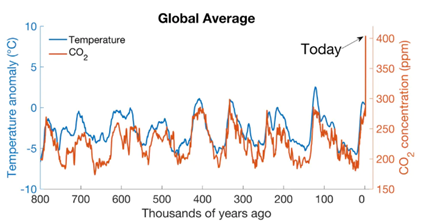
Climate change is caused by natural processes but also increasingly by human activities. The main driver of climate change is the greenhouse effect. Some gases in the atmosphere have a similar function to the glass in a greenhouse. The glass walls of a greenhouse let heat and light from the Sun in, which warms up the air inside. Similarly, greenhouse gases let the incoming heat from the Sun pass through to the Earth’s surface, where it is trapped. Many of these gases occur naturally, and natural causes of changes to the greenhouse effect include solar radiation and volcanic activity. But human activities are increasing the concentrations of some greenhouse gases in the atmosphere, in particular carbon dioxide, methane, nitrous oxide and fluorinated gases, leading to an enhanced greenhouse effect and warmer temperatures.
The main human activities causing these changes are:
- Burning of fossil fuels such as coal, oil and gas, which produce carbon dioxide and nitrous oxide
- Deforestation, which means that there are less trees to help absorb carbon dioxide from the atmosphere, and carbon stored in the trees is released to the atmosphere
- Increasing livestock farming, which is problematic as cows and sheep, for example, produce large amounts of methane when they digest their food
- Fertilisers containing nitrogen, which produce nitrous oxide emissions
- Fluorinated gases, which are emitted from equipment and products that use these gases, such as refrigerators, air conditioners and heat pumps
While natural processes play a role in how the climate changes, what we are currently experiencing cannot be explained by natural processes alone. Since at least the mid 20th century, humans are unequivocally causing climate change, and unless we modify how we live and how we interact with the environment around us, this will continue to be the case.
Let me answer this question across the three levels of government – local, state and national (federal).
While local governments can’t influence national climate policy, they do some important things at the local level, like promoting green building design, installing busways and bikeways and improving public transport to encourage a move away from private vehicle use. They are also responsible for approving new coal mines, although in some states their ability to reject proposed new mines is limited by state-level law.
State governments can provide incentives to industry to change their industrial processes and energy inputs, or make laws actually requiring them to do so. Some state governments offer incentives for people to instal solar panels or energy efficient appliances and could use the car registration system to encourage people to buy electric vehicles.
However, consistent and coherent climate policy really rests with the federal government. The national government has laws requiring a mandatory amount of renewable energy as part of every electricity companies supply. There are also laws relating to energy efficiency. The main plank of the Federal government’s climate policy is the Carbon Solutions Fund. This involves paying individuals and businesses to undertake activities that will reduce emissions. The government initiates a reverse auction in which it invites people to indicate how many emissions reductions they could deliver, at what price. The government then buys those emissions reduction from the party offering to do so at the lowest price. This might achieve small level of emissions reduction, but it costs a lot of money and it will not deliver the kind of transformation that is desperately needed. It provides no incentive for large emitters to reduce their emissions because there are no legal obligations for them to do so and there are no costs associated with continuing with high emitting activities.
The national government could also stop new coal mines by using federal environmental laws. So far it has not done so. In fact, three new coal mines have been approved by the Commonwealth environment minister in the last two months. The Australian government has said that because this coal is intended for export and not domestic consumption, it is not Australia's responsibility to discontinue mining. The responsibility for the emissions coming from burning this coal, according to the government, should rest with the countries that buy the coal. While this may be true in a technical sense based on international carbon accounting rules, it is a missed opportunity in terms of Australia’s leadership on climate action.
Plants and animals are threatened by lots of things like habitat loss from land clearing, or being hunted, fished or harvested. On top of these pressures are climate change impacts.
Because there are so many interacting threats to biodiversity, we haven’t yet attributed many species’ extinctions only to climate change. Species that we have lost to date from climate change are species that occur only in one place, so they are very rare, and those places are exposed to immediate climate impacts such as flooding and sea level rise.
The Bramble Cay Melomys was an Australian rodent that occurred only on one island in the Torres Strait. In 2016, it became the first recorded species extinction attributed to human induced climate change. The small sand island it lived on was affected by sea level rise and storm events. The extinction record by the State of Queensland said that extinction was caused by "ocean inundation of the low-lying cay, very likely on multiple occasions, during the last decade, causing dramatic habitat loss and perhaps also direct mortality of individuals" (1). There are likely other species that have been lost to a similar fate.
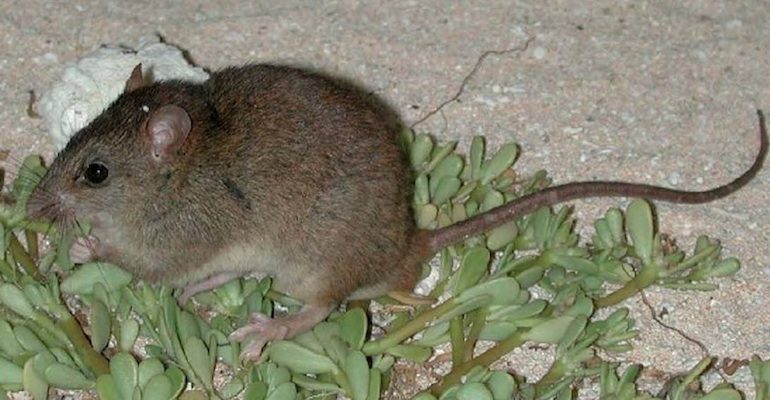
The IUCN Red List of species is the best source for understanding global threats to species. Expert have listed climate change as a cause of decline for 19% of all species listed as near threatened or threatened. Climate change impacts that threaten species include increases in storms, flooding, extreme temperatures, drought, and sea level rise.
As an example – Hooded seals are a species threatened directly by climate change. Their population has dropped in abundance by 90% in the northeastern Atlantic Arctic over the last 20 years. This decline is attributed to loss of sea ice which has reduced the number of places available for resting and raising pups.
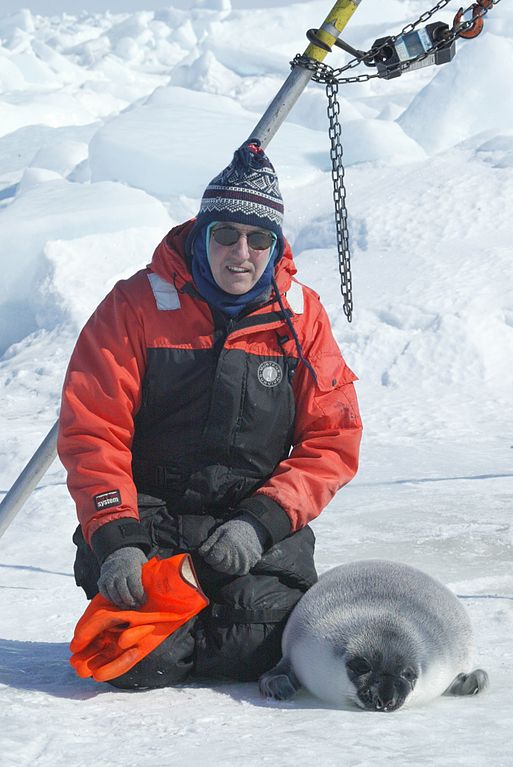
Looking into the future – One study estimated that if we follow our current, business-as-usual trajectory of climate change, which is projected to lead to a 4.3°C temperature rise, climate change would threaten one in six species (16%). This could as much as double our extinction rates.
This is one of many reasons why people are calling for governments to limit climate change to 1.5°C, by ‘decarbonising’ our economy – or stopping emissions of CO2. If we do this, we can reduce the rates at which plants and animals become extinct.
The short answer to this great question is: not as much as we’ll need to invest if we don’t make a drastic change! In the past, the cost of changing the way we do things has been used as an argument for not acting on climate change, but there are costs on both sides of that argument (that is, there is a cost to acting but there is also a cost to not acting). Climate change is making disasters like extreme bushfires and droughts more common, and these kinds of disasters already cost Australians a lot (approx. $3 trillion from 2010-2019!). These costs, which relate to damage and lost income, are going to increase a lot if we do not take urgent action on climate change.
Some people have tried to estimate how much money the world would need to spend to stop climate change, and their estimates range from $300 billion (the cheapest option!) to $50 trillion! Both of these amounts are huge and hard to imagine. The big difference between the cheapest and most expensive estimates also show us that working out exactly how much investment is required is a really hard maths problem! It’s hard because the final cost will depend on lots of things, like whether people agree on what to do, who should do it, and when, but also on how quickly we all make the drastic changes that are needed. For example, we know we need to shift from using fossil fuels to renewable energy, but the cost of doing it quickly (which might include governments paying some of the costs for people to install solar power, big batteries and other renewable options at their homes) might be really different from making that change slowly (which might mean that companies and governments waste money building or upgrading fossil fuel buildings that they can’t use because fossil fuels are banned).
Importantly, we need to remember that money we spend now to get ready for the challenges of climate change will benefit young people alive today and all of the people that come after us, as well as natural systems like our coasts and beaches, wetlands and forests. Investing in drastic change is definitely ‘worth it’, because this is an investment for all of us, and for our children’s children, and for the places that we love the most.
This is a great question and a really important one, because if we can understand what the main threats of climate change are, we can do something about them! The first thing to understand is that we are talking about anthropogenic climate change. This refers to climatic changes caused by human activities (anthropocentric meaning human). Climate change is ultimately caused by releasing greenhouse gases into the atmosphere which contributes to global warming. You can find some great information about greenhouse gases, global warming and their relationship with climate change from Dr Beth Fulton and Deniz Yildiz.
Threats are, therefore, activities that contribute greenhouse gases to the atmosphere. The biggest threat and production of greenhouse gas emissions is our use of fossil fuels. Fossil fuels are hydrocarbon-containing materials, such as coal, petrol and natural gas, formed underground from the remains of dead plants and animals a long, long time ago that humans extract to use for things like generating electricity, driving cars and machinery.
Another major threat is deforestation which is the cutting down and often burning of forests, such as the Amazon rainforest, and also forests here in Tasmania.

Intensive agriculture contributes significantly to the release of greenhouse gases to the atmosphere as well. Cows and sheep produce large amounts of methane (a greenhouse gas) when they digest their food, and this gas adds to the greenhouse effect on the Earth. Furthermore, animals need fields to graze on, and this leads to deforestation.
The use of nitrogen fertilisers to support intensive agriculture is another contributor to climate change because they produce nitrous oxide emissions.
Last, but by no means least, fluorinated gases contribute to greenhouse gas emissions. These particularly damaging gases are emitted from equipment and products such as commercial and industrial refrigerators, air-conditioning systems and heat pumps. Such emissions have a very strong warming effect, up to 23,000 times greater than that of carbon dioxide.
What is important to remember though is that there is great work being done to combat ALL of these threats.













